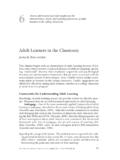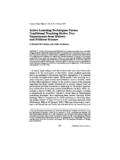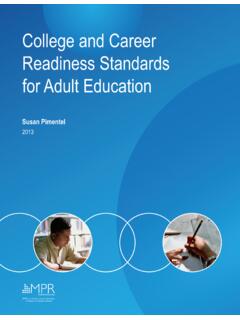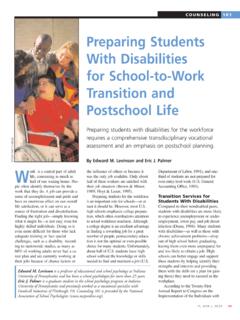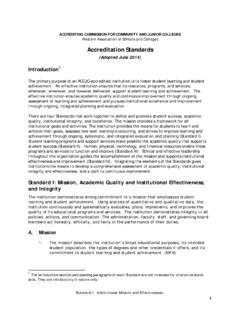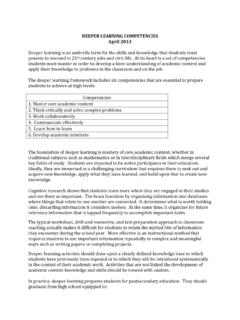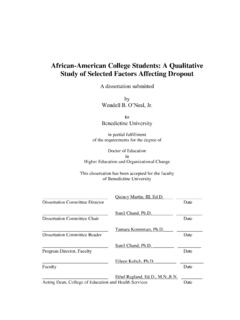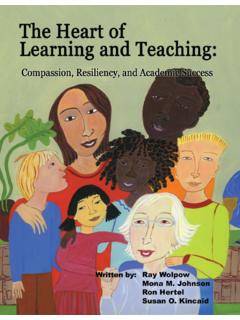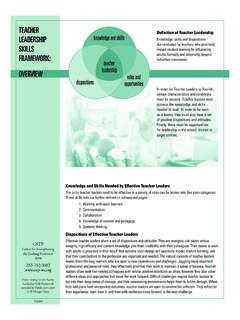Transcription of Multiple Roles of Adult Learners - Robert Vroman
1 Adult Learners juggle Multiple Roles while attendinginstitutions of higher education. Adult students Roles andthe implications for adults success in college arediscussed in this FORSTUDENTSERVICES, no. 102, Summer 2003 Wiley Periodicals, Roles of Adult LearnersEllen E. FairchildAs readers will find in other chapters of this volume, Adult , or nontradi-tional, students compose one of the fastest growing segments of higher edu-cation s student populations. Adult Learners palette of life experience iscolored with older age, full-time employment, and the Roles of spouse andparent (Villela and Hu, 1991). The combinations of life experience and fam-ily configurations are as plentiful and extraordinary as the number of education is only one of the many activities in which Adult stu-dents are involved.
2 For one thing, adults often are employed full-time. Inaddition to their work Roles , adults are caregivers for children and agingrelatives, community leaders, and volunteer workers. Although Adult stu-dents are unique individually, they share some common traits. Typically, adults are on campus only for classes or administrative requirements, asopposed to social or athletic activities (O Connor, 1994), and they navigatecollege independently, without an age cohort (Benshoff and Lewis, 1992).As Carol Kasworm notes in Chapter One, most adults attend school part-time. They do not live on campus, are not involved in campus organiza-tions, and their social groups are not associated with the college (Bradleyand Graham, 2000).
3 Generally, adults take an interest in higher education when they havedetermined that there will be a return on their investment of time, money,and effort (Tharp, 1988). Because Adult students finance most of their edu-cation (O Connor, 1994), they protect their investment through theirachievement orientation and high motivation (Benshoff and Lewis, 1992). adults attend class, work seriously (Graham and Donaldson, 1999), andvalue opportunities to integrate academic learning with life and work expe-riences (Benshoff and Lewis, 1992).12 MEETING THESPECIALNEEDS OFADULTSTUDENTSC hickering and Havighurst (as cited in Terrell, 1990) describe severaladult transitions that have an effect on Adult students participation inhigher education.
4 As adults build families, careers, and positions withintheir communities, their perception of higher education changes. Ratherthan being a life-encompassing, identity-building experience, such as theone we hope to provide for traditional-aged students, higher education foradults is one activity among many in which adults can participate to meetother specific needs, such as learning a new job-related skill or preparingfor a new career adults differences from the traditional-aged students with whomwe are most familiar and their differences from and commonalities with oneanother, how can we best support them to persist and succeed in highereducation?
5 In this chapter, I intend to begin to answer this ProblemsOnce adults have made the decision to enter higher education, threats tosuccess caused by Multiple role demands and institutional barriers form aweb of perception, constraint, and role demands. Mercer (1993) dividesbarriers to persistence into three classes: situational, dispositional, andinstitutional. Family, job, and civic commitment all play a part in deter-mining situational barriers. Dispositional barriers are intrapersonal andconsequently much harder to define, and they include dissonance amongrole demands. Institutional barriers are systemic barriers that exclude adultsor make it difficult for them to successfully navigate through their feel guilt about being unavailable whentheir children need them, with mothers of children younger than thirteenfeeling the most conflict (Terrell, 1990).
6 The age of the children may welldetermine the persistence of women. Those with older children may persistto graduation, whereas those with young children may interrupt or stoptheir education (Carney-Crompton and Tan, 2002).Finances play a significant role in the ability of adults to complete theiracademic goals. In addition to tuition and related expenses, parents withyoung children may have to pay for child care while at work and in families cannot afford such services as child care or summercamp while school is out of session (Terrell, 1990). Time and energy spenttrying to make ends meet can drain the most dedicated income, the number of dependents in the household, and thefinancial aid received by the student are all variables that determine the per-sistence rate of Adult students (Carney-Crompton and Tan, 2002).
7 Althoughother variables can be negotiated, income levels cannot. The basic needs ofthe family, like food and rent or mortgage, take priority over OFADULTLEARNERS13 Job responsibilities are both a blessing and a curse for Adult of employment have a positive effect on the psychological well-beingof adults (Chartrand, 1992) but at the cost of most of their spare time(Terrell, 1990). Adult students may have to make career compromises forthe sake of both their families and their academic work (Terrell, 1990),leading to health and financial (1998) reports three dimensions of rolestrain among women: Role conflict from simultaneous, incompatible demands Role overload, or insufficient time to meet all demands Role contagion, or preoccupation with one role while performing anotherIncreases in Roles , demands, and time conflicts are associated with highstress, anxiety, and depression for Adult female students (Carney-Cromptonand Tan, 2002).
8 Mothers of young children experience more role conflict(Home, 1998) and guilt over being unavailable to their children (Terrell,1990). Women with low income report more role conflict (Home, 1998),perhaps because of the lack of funds to ease the Multiple task students report role overload, and student, family, and jobdemands all contribute to role contagion (Home, 1998). Many full-time stu-dents are unable to fully anticipate the effects of their combined role contrast to jobs with fixed hours, student and family demands never seemto end. Caregivers may be more vulnerable to role contagion because of theguilt associated with the demands of their other Roles (Home, 1998).
9 Support from family and friends is essential when adults are makingthe decision to stay in school or stop out (Chartrand, 1992). Carney-Crompton and Tan (2002) report that traditional-aged students have moresupportive individuals available in their lives than do Adult students. Thismay well be an area in which institutions can develop services to strengthensocial support often are not structured to accommo-date Adult students (Benshoff and Lewis, 1992). Colleges and universitiesare ill equipped to deal with the career orientation of adults (Bauer andMott, 1990), and class work may do little to meld life experiences into aca-demic subject matter.
10 Office and class hours may not meet the needs of stu-dents who work and care for families, and the institution may ignore ordiscredit the civic and school involvement important to Adult students may never find a cohort of similar students with whom theycan connect socially or understandings of students are contrary to Adult students experiences and needs. For instance, student affairs professionals learn earlyand often that by fostering student involvement, they foster student devel-opment. However, the dominant definition of student involvement the14 MEETING THESPECIALNEEDS OFADULTSTUDENTS amount of physical and psychological time and energy that students investin both out-of-class and in-class activities (Graham and Donaldson, 1999,p.)
